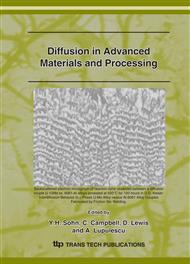p.109
p.119
p.131
p.149
p.157
p.171
p.181
p.191
p.199
Interdiffusion in (fcc) Ni-Cr-X (X = Al, Si, Ge or Pd) Alloys at 700°C
Abstract:
Interdiffusion at 700°C for Ni-22at.%Cr (fcc γ phase) alloys with small additions of Al, Si, Ge, or Pd was examined using solid-to-solid diffusion couples. Rods of Ni-22at.%Cr, Ni- 21at.%Cr-6.2at.%Al, Ni-22at.%Cr-4.0at.%Si, Ni-22at.%Cr-1.6at.%Ge and Ni-22at.%Cr-1.6at.%Pd alloys were cast using arc-melt and homogenized at 900°C for 168 hours. The diffusion couples were assembled with alloy disks in Invar steel jig, encapsulated in Argon after several hydrogen flushes, and annealed at 700°C for 720 hours. Experimental concentration profiles were determined from polished cross-sections by using electron probe microanalysis with pure standards of Ni, Cr, Al, Si, Ge and Pd. Interdiffusion fluxes of individual components were calculated directly from the experimental concentration profiles, and the moments of interdiffusion fluxes were examined to determine average ternary interdiffusion coefficients. Effects of ternary alloying additions on the interdiffusional behavior of Ni-Cr-X alloys at 700°C are presented in the light of the diffusional interactions and the formation of protective Cr2O3 scale.
Info:
Periodical:
Pages:
191-198
Citation:
Online since:
September 2007
Authors:
Price:
Сopyright:
© 2007 Trans Tech Publications Ltd. All Rights Reserved
Share:
Citation:


